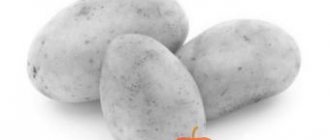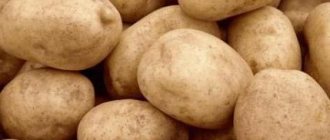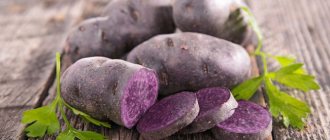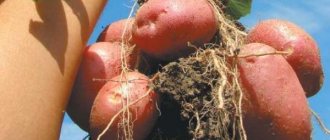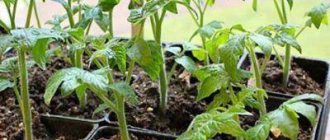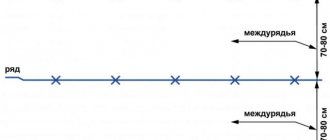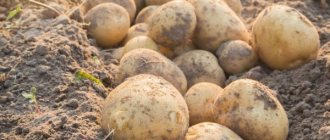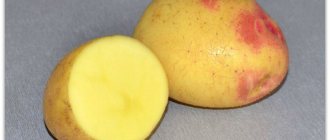Highly productive and resistant to major diseases, Bellarosa potatoes are actively grown both in household plots and in large farms. Among the variety of varieties, this variety of popular agricultural crop quickly adapts to growing conditions and is resistant to adverse environmental factors. In order to grow not only a high-quality, but also a rich harvest, you need to become familiar with the characteristics of the variety, the basic rules for its planting and subsequent care.
Description of the variety Bellarosa
Early potatoes are characterized by rapid germination and accelerated growth rates. From planting to harvesting, no more than 1.5-2 months pass. The bushes are tall, spreading, up to half a meter high. The leaves are large, dark green with a slightly corrugated edge. The inflorescences consist of small flowers of purple shades. Vegetable crops are assessed by the quantity and quality of root crops. Main characteristics of Bellarosa:
- tuber shape – oval-round;
- the peel is bright pink, rough;
- the pulp is dense, yellow;
- eyes small, few leaves.
Reference! Bellarosa seed potatoes are used for early production. In the southern regions, it is quite possible to get 2 harvests during the growing season.
7-10 large root crops, up to 200 g, are formed in the bush. Under favorable conditions, individual tubers can reach a weight of 600-800 g. The yield, depending on regional characteristics, soil quality and care, reaches 30-40 tons per hectare. Marketability is high, up to 95%. The variety is universal, suitable for preparing any dishes.
The video shows the Bellarosa potato harvest:
Video
An experienced vegetable grower from the Pavlovsky district of the Nizhny Novgorod region shares his opinion about the most productive potato varieties, including Bellarosa, in the following video:
For several years she worked as a television program editor with leading producers of ornamental plants in Ukraine. At the dacha, of all types of agricultural work, she prefers harvesting, but for this she is ready to regularly weed, pull, shed, water, tie, thin out, etc. I am convinced that the most delicious vegetables and fruits are those grown with your own hands!
Found a mistake? Select the text with the mouse and click:
Tomatoes have no natural protection against late blight. If late blight attacks, any tomatoes (and potatoes too) die, no matter what is said in the description of the varieties (“variety resistant to late blight” is just a marketing ploy).
In Australia, scientists have begun experiments in cloning several varieties of grapes grown in cold regions. Climate warming, which is predicted for the next 50 years, will lead to their disappearance. Australian varieties have excellent characteristics for winemaking and are not susceptible to diseases common in Europe and America.
It is believed that some vegetables and fruits (cucumbers, stem celery, all varieties of cabbage, peppers, apples) have “negative calorie content,” that is, more calories are consumed during digestion than they contain. In fact, only 10-20% of the calories received from food are consumed in the digestive process.
A new product from American developers is the Tertill robot, which weeds weeds in the garden. The device was invented under the leadership of John Downes (creator of the robot vacuum cleaner) and works autonomously in all weather conditions, moving over uneven surfaces on wheels. At the same time, it cuts off all plants below 3 cm with the built-in trimmer.
The homeland of pepper is America, but the main breeding work on developing sweet varieties was carried out, in particular, by Ferenc Horvath (Hungary) in the 20s. XX century in Europe, mainly in the Balkans. Pepper came to Russia from Bulgaria, which is why it received its usual name - “Bulgarian”.
One of the most convenient methods for preparing a harvest of vegetables, fruits and berries is freezing. Some believe that freezing causes the nutritional and health benefits of plant foods to be lost. As a result of the research, scientists have found that there is practically no decrease in nutritional value when frozen.
Natural toxins are found in many plants; Those grown in gardens and vegetable gardens are no exception. Thus, the seeds of apples, apricots, and peaches contain hydrocyanic acid, and the tops and peels of unripe nightshades (potatoes, eggplants, tomatoes) contain solanine. But do not be afraid: their number is too small.
Humus is rotted manure or bird droppings. It is prepared like this: the manure is piled up in a heap or pile, layered with sawdust, peat and garden soil. The pile is covered with film to stabilize temperature and humidity (this is necessary to increase the activity of microorganisms). The fertilizer “ripens” within 2-5 years, depending on external conditions and the composition of the feedstock. The output is a loose, homogeneous mass with a pleasant smell of fresh earth.
“Frost-resistant” varieties of garden strawberries (more often simply “strawberries”) need shelter just as much as ordinary varieties (especially in those regions where there are snowless winters or frosts alternating with thaws). All strawberries have superficial roots. This means that without shelter they freeze to death. Sellers’ assurances that strawberries are “frost-resistant,” “winter-hardy,” “tolerates frosts down to −35 ℃,” etc. are deception. Gardeners must remember that no one has yet managed to change the root system of strawberries.
Characteristics of the variety
Bellarosa potatoes received the highest ratings from vegetable growers due to their characteristic advantages:
- unpretentiousness;
- drought resistance;
- high taste qualities;
- resistance to mechanical damage;
- excellent keeping quality;
- high transportability;
- resistance to diseases.
"Bellarose" grows well in almost any type of soil. Slightly lower yields are achieved on heavy clay soil. Good harvests are guaranteed even in dry weather conditions.
What reviews does the variety have?
Buyers like Bellarosa for the pleasant taste that new potatoes have. Growers love this variety for its ease of cultivation and productivity.
Ivan, Izhevsk:
“Bellarose grows on any soil except heavy clay soil. There is enough rainfall for the bush to form a decent harvest. The tubers look beautiful, they are smooth, dense, and easy to clean. Potatoes can be stored for a long time, retaining yellow flesh that does not turn black, which is observed in other varieties.”
Vasily, Krasnoyarsk:
“The variety is stable, all potatoes are the same size, there are almost no small and medium ones. When feeding, the weight of one tuber reaches up to 800g. In order for Bellarosa to maintain its characteristics, I recommend updating the seed fund every three years. I finish harvesting this variety in mid-September.”
Alexander, Ekaterinburg:
“This variety has insufficient resistance to late blight. If there are prolonged rains in July, during which the air temperature will be above 22C, then the humid, warm environment will contribute to the defeat of Bellarosa bushes by phytosporosis. Knowing this feature of the variety, I carry out the first treatment with Tattu, which is excellent for all nightshade crops. The second treatment with Quadris before flowering increases the resistance of the tops to infection.”
Irina, Krasnodar: I think that Bellarosa potatoes can be classified as the best early varieties. Its large tubers grow without much physical effort. The skin of young potatoes is thin, easily removed when peeling, and the tubers themselves have a pleasant taste.
The time has come to abandon the old types of potatoes inherited from our parents. It is necessary to purchase new, more productive, low-maintenance varieties. Their use requires less cultivated area. The tubers have good taste, are better stored, and even during germination they retain an elastic, dense mass that does not flake if storage rules are violated.
Preparatory work before planting
Before starting work, it is necessary to select a suitable site. Compliance with crop rotation is a prerequisite, so you should be careful about the quality of the soil and its predecessors. The most suitable vegetable crops:
- cucumbers;
- pumpkin crops;
- legumes
Soil preparation begins in autumn. Before plowing, organic matter is added: manure, humus or compost.
Reference! The Bellarosa variety responds well to the presence of dolomite flour in the soil.
In the spring, the area is dug up again, and mineral fertilizers are applied if necessary.
Before the planned planting, 2-3 weeks before, the potatoes are taken out of storage and placed in a warm place. Lay out in 2-3 layers in boxes, lightly sprinkle with water. You can start planting only when the sprouts grow at least 1 cm.
The most suitable size when choosing tubers as planting material should be based on size and quality. The potato should not be less than 5-7 cm in length. The skin should be free of mechanical damage and signs of disease.
Large tubers are cut into several parts, provided that each part contains at least 3 healthy shoots. It is recommended to treat the cut with wood ash or crushed activated carbon for 2-3 days.
Advice! Seed material must be changed after 3-4 years. Selected potatoes – after 5 years.
Before planting, preventive treatment is carried out with a solution of potassium permanganate. Insecticides and fungicides are used against diseases and pests.
Disease resistance of the White Rose variety
"White Rose" is a hybrid variety that has good immunity. When breeding vegetables, breeders focused on plant immunity and high yield. Scientists have achieved potato resistance against major diseases:
- cancer lesions;
- potato nematode;
- late blight;
- rot caused by strains of bacteria;
- viruses of groups “U” and “A”;
- black leg;
- twisting the sheet plate;
- spotting.
It is also worth noting that plants are extremely rarely attacked by pests. The variety is unprotected only from the Colorado potato beetle. You can fight it with the drugs “Colorado”, “Bombardir”, “Aktara”, “Korado” (the dose of each drug is written in the instructions).
Landing
Depending on weather conditions, potatoes begin to be planted from April to May. Work begins after the soil has warmed up by 10-15 degrees, when the threat of frost has passed, the site is prepared. Agricultural technology is divided into several stages:
- On the surface leveled with a rake, rows are marked at a distance of at least 70-80 cm. The distance between the bushes should be 30-40 cm. It is recommended to add wood ash to the holes. There are 3 planting methods used; smooth, trench, ridge.
- The tubers are laid out with their eyes facing up and sprinkled with soil.
- The area is leveled, and if necessary, if the soil is dry, watering is carried out.
On depleted soils, phosphorus fertilizers are added before planting.
Growing
Selecting a location
Potato bushes like to grow in a sunny place with loose soil. After collecting root crops, it is better to plant mustard or rye in place of potatoes before winter. These plants will be an excellent soil supplement.
It is necessary to take care of the fertility of the soil in advance in the fall, when digging it, apply fertilizers. They are also used in the spring. Humus is suitable for this.
Preparation
14-21 days before planting, planting material must be removed from storage and spread on a flat surface in one layer. A bright room where the temperature is 15 degrees is suitable for this. When such conditions are created, the eyes will begin to awaken, which will allow for strong and friendly shoots.
Expert opinion
Filatov Ivan Yurievich, private farmer for more than 30 years
It is allowed to treat planting material with growth stimulants, this is especially true for regions with a cold summer climate.
Landing
Planting work should be carried out in early May, when the soil warms up by 10 cm to a temperature of 9 degrees. Prepared tubers need to be planted to a depth of 8-10 cm, using one of the following methods:
- smooth - dig holes on a flat surface;
- trench - planting beetles in dug trenches;
- ridge - making ridges 15 cm high and laying planting material in them.
For planting, you need to use the following scheme - 90x40 cm, since about 10 fruits are formed on one plant. If planting is too frequent, the formation of tubers will slow down, which will have a bad effect on the amount of harvest obtained.
Care
To obtain a full and abundant harvest, it is necessary to follow the recommended agrotechnical methods:
- Regular weeding and loosening to remove weeds and saturate the soil with oxygen.
- Hilling must be carried out at least 3 times during the growing season.
- Water at a rate of at least 2 liters. for 1 bush.
- Treat if necessary against pests and diseases.
During the rainy season, watering is stopped. In the northern regions, to protect crops from frost, potatoes are planted in film greenhouses or non-woven materials are used.
Growing and caring for potatoes
- The time for planting potatoes depends on the growing region. In the South, potatoes can be grown in two waves. The first wave of planting occurs in May, the second in July. The harvest is harvested during the first wave - at the end of June, and during the second - in September. Potatoes from the second wave should be left for winter storage.
In other regions, potatoes are grown in one wave. Planting is carried out at the end of May, beginning of June, when the soil warms up sufficiently. Harvest occurs in August.
You may be interested in: Dates for planting potatoes in 2021 for central Russia and the Moscow region Dates for planting potatoes in May-June 2021 according to the lunar planting calendar Favorable days for planting potatoes in 2021 according to the lunar calendar
- There are no special features in planting technology, but the soil for cultivation needs to be prepared in the fall. The soil is dug up at least 30 centimeters, humus is added to it (consumption 8 kilograms per square meter). In the spring, before planting tubers, ammonium nitrate and ammonium sulfate are added to accelerate the growth and development of potatoes. Potatoes are sprouted for 3 weeks in rooms with an air temperature of +15°C.
- To protect against attacks by the Colorado potato beetle, tubers must be treated with the drug “Prestige” before planting. Planting potatoes should be sprayed two hours before planting. The chemical consumption per 1 liter of water is 10 milliliters.
- Caring for potatoes consists of the following work:
- regular watering. Despite its drought resistance, in order to get maximum yield, you need to water regularly, at least 4-6 times a month.
- timely removal of weeds.
- Loosening of the soil occurs as a crust appears on the soil surface.
- carrying out spraying when diseases and pests appear.
Fertilizer
Fertilizers are necessary for any vegetable crop. When growing Bellarosa, you should fertilize the area in stages:
- After the first shoots appear, organic fertilizers must be used. Spill each bush under the root with a solution of mullein or chicken droppings.
- Before flowering, feed with ash and potassium sulfate.
- During the period of active flowering, fertilize with superphosphate.
To avoid burning young plants, fertilizer solutions are applied after rain or on pre-moistened soil.
Diseases and pests
"Bellarose" is a disease-resistant variety. The Achilles heel of potatoes is late blight. Thanks to early ripening, in most cases this problem can be avoided. However, the risk of disease exists in the event of prolonged rains and temperature changes. For preventive purposes, treatment with copper sulfate, Bordeaux mixture, and fungicides is used. The most effective:
- "Tattu";
- "Quadris";
- "Maksim";
- "Ridomil Gold";
- "Unomil".
Reference! Potatoes affected by late blight cannot be used for propagation.
To get rid of wireworms, traps are placed on the site. Pieces of potatoes are planted on wooden pegs and installed around the perimeter, deepening them by 10-15 cm. The work is carried out 2-3 days before planting.
The most dangerous pest is the Colorado potato beetle. Adults and larvae are collected manually or the bushes are treated with chemicals. To combat cabbage moth, pesticides are placed directly into holes during planting or incorporated into the soil during weeding.
Advantages and disadvantages
Considering the varietal characteristics, Bellarosa potatoes have the following list of advantages:
- high degree of productivity;
- resistance to numerous pathogenic microorganisms;
- undemanding to growing conditions;
- grows on any soil;
- sufficient resistance to dry periods;
- the ability to form tubers in soil that is waterlogged by rain;
- resistance to cold weather;
- transportability;
- good keeping quality;
- the ability to grow and develop in the absence of an irrigation system.
Among the disadvantages of the Bellarosa variety, experienced gardeners note the ripening of potatoes away from the growing point. When harvesting occurs manually, there is a high probability of damage to the tubers; they are cut with a shovel and may not be in sight.
In addition, potatoes suffer greatly from the invasion of wireworms and the Colorado potato beetle. It is possible to avoid the attacks of these parasitic individuals only with the use of agrochemicals used for preventive purposes.
In most cases, early varieties are not suitable for long-term storage. But Bellarosa perfectly retains its density, does not lose its taste, and when stored in winter, losses amount to only 4-6% of the total mass.
Cleaning and storage
Before harvesting, it is necessary to first remove all above-ground parts. The stems are cut or mowed within 2 weeks and taken outside the site, placed in compost pits if desired. The dug up root crops are sorted and laid out to dry.
Advice! Potatoes with visible signs of damage should not be stored for storage. Seed material is selected immediately and placed in separate boxes or containers.
The variety is stored for a long time, retaining its appearance and taste until the date of intended planting. Potatoes are periodically inspected, removing tubers with traces of rot and signs of disease. To improve the preservation of large volumes, tubers are treated with chemicals.
How to increase productivity
Potatoes are dug up for storage in August or September. It is not recommended to dig up tubers earlier, as they will not survive even until winter. Harvesting should be done in dry weather so as not to waste time drying the fruits. Before placing potatoes in the cellar, they need to be sorted. First, tubers are selected for planting, the remaining potatoes are sorted by size, and damaged, rotten fruits are discarded.
Farmers with experience in growing Bellarosa potatoes are advised to take into account a number of factors that help increase yields.
When planting, add 700 g of humus and 5 tablespoons of ash or 15 g of nitrophoska into the hole. You can add onion peels to repel wireworms.
It is recommended to place the furrows from north to south. In this case, the rows are evenly illuminated, first at sunrise, then at noon, and then from the western side. The heating of the ground near the bushes is uniform.
Potato furrows are positioned from north to south so that the plants receive as much light and heat as possible
On fertilized soil, the yield of the bush will be greater. Before the first hilling, add 1 teaspoon of ammonium nitrate and 1.5 cups of humus under the plant. It is very good to feed with mullein infusion (1:10). During the budding period, the plant needs potassium - 100 g of ash or 10 g of potassium sulfate is enough. After flowering, to accelerate the growth of tubers, apply 2 tbsp under the bush.
spoons of superphosphate and 200 g of mullein per 10 l. Bellarosa especially needs magnesium, which has a great influence on tuber formation. A deficiency of this element leads to decreased resistance to disease. On neutral and slightly acidic soils, add magnesium sulfate, on acidic soils - dolomite flour (50 gm2).
Potato beds and row spacing can be mulched with sawdust and hay. Mulch with a layer of 5–10 cm retains heat and moisture well and is an obstacle to the spread of weeds. As a mulching material, you can use black agrofibre, which covers the soil under the bushes.
When the stems of the bush begin to fall and wither, the harvest is ready. Two weeks before harvesting root crops, all tops should be removed from the area.
2 weeks before harvesting root crops, remove all tops

